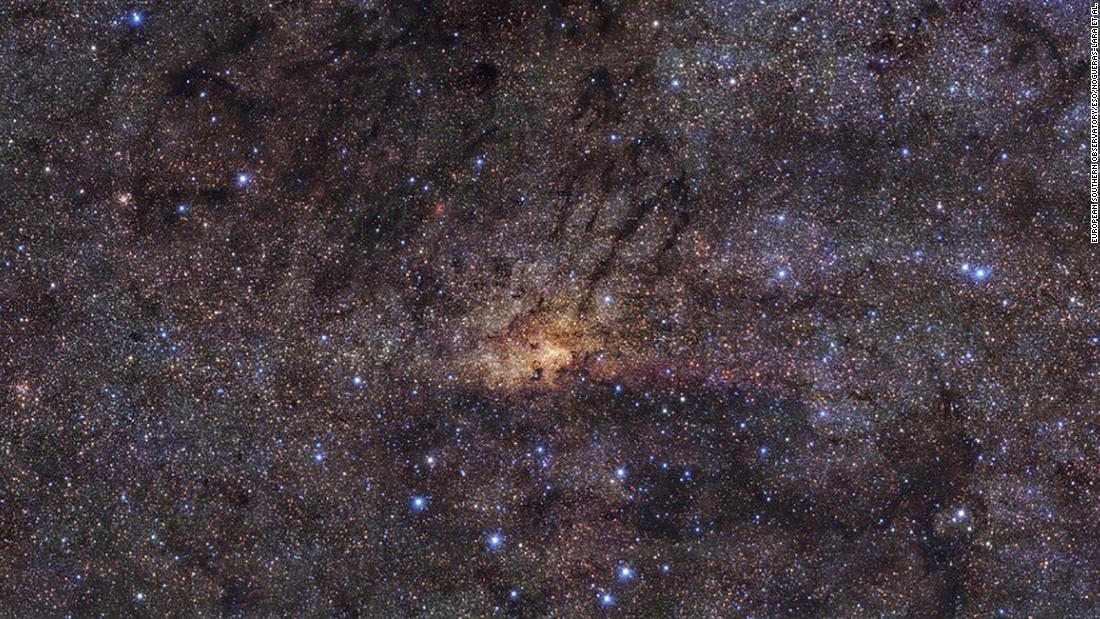Top News
There could be 36 communicating intelligent civilizations in our galaxy, study says

Maybe we’re not.
Scientists have calculated that there could be a minimum of 36 active, communicating intelligent civilizations in our Milky Way galaxy, according to a new study. However, due to time and distance, we may never actually know if they exist or ever existed.
Previous calculations along these lines have been based on the Drake equation, which was written by astronomer and astrophysicist Frank Drake in 1961.
“Drake developed an equation which in principle can be used to calculate how many Communicating Extra-Terrestrial Intelligent (CETI) civilizations there may be in the Galaxy,” the authors wrote in their study. “However, many of its terms are unknowable and other methods must be used to calculate the likely number of communicating civilizations.”
So scientists at the University of Nottingham developed their own approach.
“The key difference between our calculation and previous ones based on the Drake equation is that we make very simple assumptions about how life developed,” said study coauthor Christopher Conselice, a professor of astrophysics at the University of Nottingham, in an email to CNN.
“One of them is that life forms in a scientific way — that is if the right conditions are met then life will form. This avoids impossible to answer questions such as ‘what fraction of planets in a habitable zone of a star will form life?’ and ‘what fraction of life will evolve into intelligent life?’ as these are not answerable until we actually detect life, which we have not yet done.”
They developed what they call the Astrobiological Copernican Principle to establish weak and strong limits on life in the galaxy. These equations include the history of star formation in our galaxy and the ages of stars, the metal content of the stars and the likelihood of stars hosting Earth-like planets in their habitable zones where life could form.
The habitable zone is the right distance from a star, not too hot or too cold, where liquid water and life as we know it may be possible on the surface of a planet.
Of these factors, habitable zones are critical, but orbiting a quiet, stable star for billions of years may be the most critical, Conselice said.
“The two Astrobiological Copernican limits are that intelligent life forms in less than 5 billion years, or after about 5 billion years — similar to on Earth where a communicating civilization formed after 4.5 billion years,” said coauthor Tom Westby, an assistant professor in the University of Nottingham’s faculty of engineering, in a statement.
The Astrobiological Copernican Strong limit is that life must form between 4.5 to 5.5 billion years, as on Earth, while the weak limit is that a planet takes at least 4 billion years to form life, but it can form anytime after that, the researchers said.
“It is called the Astrobiological Copernican Principle because it makes the assumption that our existence is not special,” Conselice said. “That is, if the conditions in which intelligent life on Earth also developed somewhere else in the Galaxy then intelligent life would develop there in a similar way.”
Based on their calculations using the Astrobiological Copernican Strong limit, they determined that there are likely 36 active and communicating intelligent civilizations across our galaxy. This assumes that life forms the way it does on Earth — which is our only understanding of it at the moment. It also assumes that the metal content of the stars hosting these planets are equal to that of our sun, which is rich in metals, Westby said.
The researchers believed the strong limit is the most likely because “it still allows intelligent life to form within a billion years after it did on Earth, which seems like plenty of time,” Conselice said.
Another assumption of these potential civilizations is that they’re making their presence known in some way via signals.
Currently, we’ve only been producing signals like radio transmissions from satellites and televisions for a short time. Our “technological” civilization is about a hundred years old. So imagine about 36 others doing the same thing across the galaxy.
The researchers were surprised that the number was so small — but not zero. “That is fairly remarkable,” Conselice said.
Even though this study only looked at our galaxy, distance is an inhibiting factor. The researchers calculated that the average distance between these potential civilizations would equal about 17,000 light-years. Detecting those signals or sending communications using current technology would take so long that it would be nearly impossible.
“The search for intelligent life is only expected to yield a positive observation if the average life-span of [communicating extra-terrestrial intelligence] within our Galaxy is 3,060 years. That is to say, our communicating civilization here on Earth will need to persist for 6,120 years beyond the advent of long-range radio technology (approximately 100 years ago) before we can expect a [search for extra-terrestrial intelligence] two-way communication.”
Under the more relaxed assumptions of the Weak Copernican case, there would be a minimum of 928 civilizations communicating in our galaxy today, according to the study, meaning more of them at closer range. This would only require about 700 years to make a detection.
Life span of a civilization
“It is clear that the lifetime of a communicating civilization is the key aspect within this problem, and very long lifetimes are needed for those within the Galaxy to contain even a few possible active contemporary civilizations,” the researchers wrote in their study.
And then there’s the question of survival. Are other potential civilizations as long-lived as those on Earth?
If the search for this life reveals nothing within a distance of 7,000 light-years, the researchers suggest that this could mean one of two things.
First, it could suggest that the lifetimes of these civilizations are shorter than 2,000 years — which could mean that our own is nearing its end.
Second, it could suggest that life on Earth is unique and occurs in a much more random process than the Astrobiological Copernican Limits established in the study.
Not all factors or limitations were included in the study, like the fact that the small M-dwarf stars these Earth-like planets may be orbiting may release harmful radiation “that would make life difficult to exist,” which is a debated issue, Conselice said. M-dwarf stars are common in our galaxy and have been known to host rocky, Earth-size planets.
Next, the researchers will look beyond our galaxy to see if life may exist outside of its boundaries.
“Our new research suggests that searches for extraterrestrial intelligent civilizations not only reveals the existence of how life forms, but also gives us clues for how long our own civilization will last,” Conselice said.
“If we find that intelligent life is common then this would reveal that our civilization could exist for much longer than a few hundred years, alternatively if we find that there are no active civilizations in our Galaxy it is a bad sign for our own long-term existence. By searching for extraterrestrial intelligent life — even if we find nothing — we are discovering our own future and fate.”

General internet buff. Hardcore music maven. Typical foodaholic. Friendly student.
Top News
Portuguese historical films will premiere on 29 December.

Method Media Bermuda will present the documentary FABRIC: Portuguese History in Bermuda on Thursday, December 29 at the Underwater Research Institute of Bermuda.
A spokesperson said: “Method Media is proud to bring Bermuda Fabric: Portugal History to Bermuda for its 5th and 6th showing at the Bermuda Underwater Observatory. In November and December 2019, Cloth: A Portuguese Story in Bermuda had four sold-out screenings. Now that Bermuda has reopened after the pandemic, it’s time to bring the film back for at least two screenings.
“There are tickets Ptix.bm For $ 20 – sessions at 15:30 and 18:00. Both screenings will be followed by a short Q&A session.
Director and producer Milton Raboso says, “FABRIC is a definitive account of the Portuguese community in Bermuda and its 151 years of history, but it also places Bermuda, Acors and Portugal in the world history and the events that have fueled those 151 years.
“It took more than 10 years to implement FABRIC. The film was supported by the Minister of Culture, the Government of the Azores and private donors.
“Bermuda Media Method [MMB] Created in 2011 by producer Milton Raposo. MMB has created content for a wide range of clients: Bermuda’s new hospital renovation, reinsurance, travel campaigns, international sports and more. MMB pays special attention to artistic, cultural and historical content.
More about
Model: Everybody, Entertainment, Movies/Movies, History, News

Proud web evangelist. Travel ninja. Creator. Freelance food nerd. Passionate bacon fanatic.
Top News
CRISTANO RONALDO CAN MAKE UP A GIANT IN CARIOCA AND PORTUGUESE TECHNICIAN SAYS ‘There will be room’

News
This is a fact or event of journalistic interest. This may be new or recent information. This also applies to the novelty of an already known situation.
Article
Mostly original text. Expresses the opinion of the author, but not necessarily the opinion of the newspaper. It can be written by journalists or specialists from different fields.
Investigative
A report that contains unknown facts or episodes with a pronounced denunciatory content. This requires special methods and resources.
Content commerce
Editorial content that offers the reader conditions for making purchases.
Analysis
This is the interpretation of the news, taking into account information that goes beyond the facts told. It uses data, brings events and scenario forecasts, as well as past contexts.
Editorial
Analytical text translating the official position of the vehicle in relation to the facts covered.
Sponsored
This is an institutional article on a topic of interest to the company sponsoring the report.
fact checking
Content that confirms the accuracy and authenticity of the disclosed information or facts.
Context
This is an article that brings subsidies, historical data and relevant information to help understand a fact or news.
special
An exciting report that details the various aspects and developments of this topic. It brings data, statistics, historical context, as well as stories of characters that are affected by or directly related to the topic in question.
Interview
A subject-specific approach in which the subject is presented in a question and answer format. Another way to publish interviews is through threads, where the interviewee’s answer is reproduced in quotation marks.
Criticism
A text with detailed analysis and opinions on products, services and works of art in a wide variety of fields such as literature, music, film and visual arts.

Proud web evangelist. Travel ninja. Creator. Freelance food nerd. Passionate bacon fanatic.
Top News
Maestro de Braga is the first Portuguese in the National Symphony Orchestra of Cuba.

Maestro Filipe Cunha, Artistic Director of the Philharmonic Orchestra of Braga, has been invited to conduct the Cuban National Symphony Orchestra, as announced today.
According to a statement sent by O MINHO, “he will be the first Portuguese conductor to conduct this orchestra in its entire history.”
In addition to this orchestra, the maestro will also work with the Lyceo Mozarteum de la Habana Symphony Orchestra.
The concerts will take place on 4 and 12 March 2023 at the National Theater of Cuba in Havana.
In the words of the maestro, quoted in the statement, “these will be very beautiful concerts with difficult but very complex pieces” and therefore he feels “very motivated”.
From the very beginning, Rachmaninoff’s Piano Concerto No. 2 will be performed by an Italian pianist (Luigi Borzillo), whom the maestro wants to bring to Portugal later this year. In the same concert, Mendelshon’s First Symphony will be performed.
Then, at the second concert, in the company of the Mexican clarinetist Angel Zedillo, he will perform the Louis Sfora Concerto No. 2. In this concert, the maestro also conducts Tchaikovsky’s Fifth Symphony.
“This is an international recognition of my work. An invitation that I accept with humility and great responsibility. I was surprised to learn that I would be the first Portuguese member of the Cuban National Symphony Orchestra. This is a very great honor,” the maestro said in a statement.
“I take with me the name of the city of Braga and Portugal with all the responsibility that goes with it, and I hope to do a good job there, leaving a good image and putting on great concerts. These will be very special concerts because, in addition to performing pieces that I love, especially Rachmaninov and Tchaikovsky, I will be directing two wonderful soloists who are also my friends. It will be very beautiful,” concludes Filipe Cunha.

Proud web evangelist. Travel ninja. Creator. Freelance food nerd. Passionate bacon fanatic.
-
World3 years ago
The Gabby Petito case. Brian Landry set up camp with his family after his girlfriend disappeared
-
Top News4 years ago
Tristan Thompson reacts to Khloé Kardashian’s new appearance
-
Top News4 years ago
TLC ‘sMothered’ recap: ‘Party curled up,’ boyfriend problem
-
Top News4 years ago
Alex Cooper hosts a solo podcast
-
Top News4 years ago
2021 Ford Bronco price: Here’s how much the 2-door and 4-door cost
-
Tech4 years ago
Fall Guys is supplying out a legendary costume and Kudos as an apology present
-
Top News4 years ago
Chiara de Blasio was ‘very cold’ during the arrest of the protest: witness
-
Top News4 years ago
How to Watch Yellowstone Season 3, Episode 2 Live Online
















